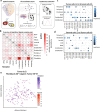Dissecting the immune suppressive human prostate tumor microenvironment via integrated single-cell and spatial transcriptomic analyses
- PMID: 36750562
- PMCID: PMC9905093
- DOI: 10.1038/s41467-023-36325-2
Dissecting the immune suppressive human prostate tumor microenvironment via integrated single-cell and spatial transcriptomic analyses
Abstract
The treatment of low-risk primary prostate cancer entails active surveillance only, while high-risk disease requires multimodal treatment including surgery, radiation therapy, and hormonal therapy. Recurrence and development of metastatic disease remains a clinical problem, without a clear understanding of what drives immune escape and tumor progression. Here, we comprehensively describe the tumor microenvironment of localized prostate cancer in comparison with adjacent normal samples and healthy controls. Single-cell RNA sequencing and high-resolution spatial transcriptomic analyses reveal tumor context dependent changes in gene expression. Our data indicate that an immune suppressive tumor microenvironment associates with suppressive myeloid populations and exhausted T-cells, in addition to high stromal angiogenic activity. We infer cell-to-cell relationships from high throughput ligand-receptor interaction measurements within undissociated tissue sections. Our work thus provides a highly detailed and comprehensive resource of the prostate tumor microenvironment as well as tumor-stromal cell interactions.
© 2023. The Author(s).
Conflict of interest statement
A.O.S. own shares in TScan Therapeutics and BioNTech. P.V.K. serves on the Scientific Advisory Board to Celsius Therapeutics Inc. and Biomage Inc. P.V.K. is an employee of Altos Labs. D.T.S. is a founder, director, and stockholder of Magenta Therapeutics, Clear Creek Bio, and LifeVaultBio. He is a director and stockholder of Agios Pharmaceuticals and Editas Medicines and a founder and stockholder of Fate Therapeutics and Geruda Therapeutics. He is a consultant for FOG Pharma, Inzen Therapeutics, ResoluteBio, and VCanBio and receives sponsored research support on an unrelated project from Sumitomo Dianippon. D.B.S. is a founder, consultant, and shareholder for Clear Creek Bio. K.S. is a recipient of sponsored research funding from Convergent Genomics. F.C. and E.Z.M. are consultants for Atlas Bio, inc. The remaining authors declare no competing interests.
Figures







Comment in
-
Singling out the immune-suppressive TME in prostate cancer.Nat Rev Urol. 2023 Apr;20(4):199. doi: 10.1038/s41585-023-00758-7. Nat Rev Urol. 2023. PMID: 36928616 No abstract available.
-
Uro-Science.J Urol. 2023 Nov;210(5):814-816. doi: 10.1097/JU.0000000000003658. Epub 2023 Aug 24. J Urol. 2023. PMID: 37615283 No abstract available.
References
Publication types
MeSH terms
Grants and funding
LinkOut - more resources
Full Text Sources
Medical
Molecular Biology Databases

